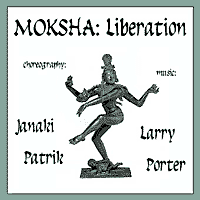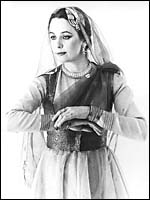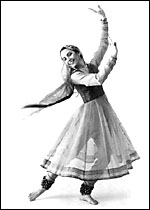
|
|
|
|
|
|
|
|
|
|
|
|
|
|
|
|
|
|
LISTEN TO RECORDINGS / PIANO
MOKSHA, An East-West Dance Oratorio |
|
from the original program notes: Tradition tells us that Ravana's devotion to Lord Shiva was so great, that he created the Indian raga/melody system so he could sing Shiva's praises. In the SHIV TANDAV STOTRA, Ravana describes Shiva's power and beauty. Both the fourth and fifth quatrains of poetry conclude with lists of Shiva's epithets as destroyer ("chidam" and "antakam"), even destroyer of death itself. Alliteration and onomatopoeia create waves of sound in this magnificent example of Sanskrit devotional poetry. A compelling and complex personality, Ravana is for many Indians a great hero. It is told that ultimately he went to Lord Shiva to request MOKSHA, release from the bondage of endless rebirth. Shiva replied that he had granted Ravana indestructibility from the powers of heaven and earth, and that Ravana must instead seek MOKSHA from Lord Vishnu. In this version of Ravana's story, we may view his battle with Rama as a pretext to attain death and thereby MOKSHA from the hand of Lord Vishnu incarnate. Ravana's poignant cry in the final quatrain of poetry - "When will I be happy?" - is one all humans share in their quest for earthly fulfillment and ultimate release from its bondage.
Hand gestures used in the dance can be read as a type of three-dimensional hieroglyphics. For example, three fingers symbolize Shiva's trident weapon, thumb and pointer at right angles are the crescent moon, cupped hand is a serpent's hood, thumb and pointer joined at mid-forehead are Shiva's third eye of inner knowledge. Traditional kavita torah's were taught to Janaki by Nala Najan. Pandit Patwardhan and Smt. Ritha Devi translated the SHIV TANDAV STOTRAM.
Listen to: Janaki Patrik
– dance & recitation (choreography by Janaki Patrik, music by Larry Porter) Cooper Union Great Hall, New York, Nov. 22, 1991 Artists' Biographies JANAKI PATRIK has been a disciple of India's renowned Kathak dancer, composer and choreographer Pandit Birju Maharaj since 1967. Her recent studies with him and research into the poetry of the Kathak dance repertoire were supported in 1988/89 by a Fulbright Senior Research Fellowship. She studied choreography, technique and repertory at the Merce Cunningham Studio from 1971 to 1978, supported by a five year scholarship. A founding member of The Kathak Ensemble in 1978, Janaki performs and teaches in the United States, Canada and India and is active in the field of arts-in-education. LARRY PORTER, jazz pianist and composer, is a founding member of The Kathak Ensemble, with whom he played sarod and rebab in their first season. Now based in Munich, Germany, Larry plays regularly in European jazz festivals and clubs with his own trio and has played with such jazz luminaries as Thad Jones, Chet Baker and Art Farmer. His "Vergänglichkeit", based on a poem by Hermann Hesse, won a prize in the 1990 Cologne competition for jazz chorus compositions. PAUL LEAKE lived in Asia from 1967-78, studying languages, philosophy and the arts of India, Nepal and Sri Lanka. He studied tabla in Nepal with Prof. Kali Prasad Sharma and in Calcutta with Ustad Keramattulah Khan. A founding member of The Kathak Ensemble, Paul also accompanies classical Indian vocal and instrumental music and composes music for video, fusion and jazz. MARJORIE JOHNSON studied harmonic singing and overtone chanting with David Hykes in New York City and worked as a vocalist with David Hykes and the Harmonic Choir. She studies North Indian classical vocal technique with Sheila Dhar and the vocal repertoire of Kathak dance with Janaki Patrik. HENNING SIEVERTS, a native of Berlin, Germany, has studied cello, bass and composition. He now lives in Munich and works as a jazz bassist with various European groups. His January '91 Australian tour with the Peter O'Mara-Mike Nock Quartet was followed by a February-March stay in New York City, where he played with various jazz groups including those of Craig Handy, Valery Ponomarev, Pete Yellin and Roy Hargrove.
|
 This
project represents the rebirth of a collaboration which began in
the late '70's and was broken off during the '80's, when Larry Porter
returned to Europe. This time around the emphasis is on combining
different worlds in a way which respects the basic essence of each
world. What has emerged is a unique blend of jazz, Indian raga and
tala, European classical music, ancient Indian poetry and Kathak
dance: an east-west dance oratorio.
This
project represents the rebirth of a collaboration which began in
the late '70's and was broken off during the '80's, when Larry Porter
returned to Europe. This time around the emphasis is on combining
different worlds in a way which respects the basic essence of each
world. What has emerged is a unique blend of jazz, Indian raga and
tala, European classical music, ancient Indian poetry and Kathak
dance: an east-west dance oratorio.  MOKSHA
also incorporates a type of poetry from the traditional Kathak repertoire
which sounds much like present-day "rap". The poems chosen praise
and describe Lord Shiva and his son Ganesh, the elephant-headed
remover of obstacles.
MOKSHA
also incorporates a type of poetry from the traditional Kathak repertoire
which sounds much like present-day "rap". The poems chosen praise
and describe Lord Shiva and his son Ganesh, the elephant-headed
remover of obstacles. 